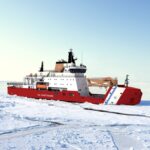
Lockheed Martin [LMT] this week said it is packaging a laser weapon system that is set to be installed on the Arleigh Burke-class destroyer USS Preble (DDG-88) this year. The company’s High Energy Laser and Integrated Optical-dazzler with Surveillance (HELIOS) system completed testing at Wallops Island, Va., in the fall and is currently being packaged and will be shipped to San Diego for installation on DDG-88, Jeanine Matthews, a Lockheed Martin official who oversees integrated warfare systems, told reporters during…

 By
By 








